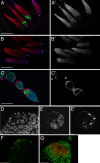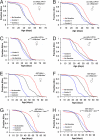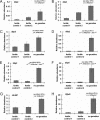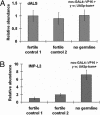Drosophila germ-line modulation of insulin signaling and lifespan
- PMID: 18434551
- PMCID: PMC2359818
- DOI: 10.1073/pnas.0709128105
Drosophila germ-line modulation of insulin signaling and lifespan
Abstract
Ablation of germ-line precursor cells in Caenorhabditis elegans extends lifespan by activating DAF-16, a forkhead transcription factor (FOXO) repressed by insulin/insulin-like growth factor (IGF) signaling (IIS). Signals from the gonad might thus regulate whole-organism aging by modulating IIS. To date, the details of this systemic regulation of aging by the reproductive system are not understood, and it is unknown whether such effects are evolutionarily conserved. Here we report that eliminating germ cells (GCs) in Drosophila melanogaster increases lifespan and modulates insulin signaling. Long-lived germ-line-less flies show increased production of Drosophila insulin-like peptides (dilps) and hypoglycemia but simultaneously exhibit several characteristics of IIS impedance, as indicated by up-regulation of the Drosophila FOXO (dFOXO) target genes 4E-BP and l (2)efl and the insulin/IGF-binding protein IMP-L2. These results suggest that signals from the gonad regulate lifespan and modulate insulin sensitivity in the fly and that the gonadal regulation of aging is evolutionarily conserved.
Conflict of interest statement
The authors declare no conflict of interest.
Figures




Similar articles
-
Dynamics of the action of dFOXO on adult mortality in Drosophila.Aging Cell. 2007 Aug;6(4):429-38. doi: 10.1111/j.1474-9726.2007.00290.x. Epub 2007 Apr 26. Aging Cell. 2007. PMID: 17465980
-
Drosophila insulin-like peptide-6 (dilp6) expression from fat body extends lifespan and represses secretion of Drosophila insulin-like peptide-2 from the brain.Aging Cell. 2012 Dec;11(6):978-85. doi: 10.1111/acel.12000. Epub 2012 Sep 18. Aging Cell. 2012. PMID: 22935001 Free PMC article.
-
Drosophila insulin-like peptide dilp1 increases lifespan and glucagon-like Akh expression epistatic to dilp2.Aging Cell. 2019 Feb;18(1):e12863. doi: 10.1111/acel.12863. Epub 2018 Dec 3. Aging Cell. 2019. PMID: 30511458 Free PMC article.
-
The role of insulin/IGF-1 signaling in the longevity of model invertebrates, C. elegans and D. melanogaster.BMB Rep. 2016 Feb;49(2):81-92. doi: 10.5483/bmbrep.2016.49.2.261. BMB Rep. 2016. PMID: 26698870 Free PMC article. Review.
-
Factors that regulate expression patterns of insulin-like peptides and their association with physiological and metabolic traits in Drosophila.Insect Biochem Mol Biol. 2021 Aug;135:103609. doi: 10.1016/j.ibmb.2021.103609. Epub 2021 Jun 17. Insect Biochem Mol Biol. 2021. PMID: 34146686 Review.
Cited by
-
Metabolic learning and memory formation by the brain influence systemic metabolic homeostasis.Nat Commun. 2015 Apr 7;6:6704. doi: 10.1038/ncomms7704. Nat Commun. 2015. PMID: 25848677 Free PMC article.
-
Regulation of longevity by the reproductive system.Exp Gerontol. 2013 Jul;48(7):596-602. doi: 10.1016/j.exger.2012.09.009. Epub 2012 Oct 11. Exp Gerontol. 2013. PMID: 23063987 Free PMC article. Review.
-
Drosophila melanogaster p53 has developmental stage-specific and sex-specific effects on adult life span indicative of sexual antagonistic pleiotropy.Aging (Albany NY). 2009 Oct 27;1(11):903-36. doi: 10.18632/aging.100099. Aging (Albany NY). 2009. PMID: 20157574 Free PMC article.
-
Regulation of fatty acid desaturase- and immunity gene-expression by mbk-1/DYRK1A in Caenorhabditis elegans.BMC Genomics. 2022 Jan 4;23(1):25. doi: 10.1186/s12864-021-08176-y. BMC Genomics. 2022. PMID: 34983389 Free PMC article.
-
Germline signaling mediates the synergistically prolonged longevity produced by double mutations in daf-2 and rsks-1 in C. elegans.Cell Rep. 2013 Dec 26;5(6):1600-10. doi: 10.1016/j.celrep.2013.11.018. Epub 2013 Dec 12. Cell Rep. 2013. PMID: 24332851 Free PMC article.
References
-
- Bell G, Koufopanou V. In: Oxford Surveys in Evolutionary Biology. Dawkins R, Ridley M, editors. Vol 3. Oxford: Oxford Univ Press; 1986. pp. 83–131.
-
- Reznick D. Costs of reproduction: An evaluation of the empirical evidence. Oikos. 1985;44:257–267.
-
- Partridge L, Gems D, Withers DJ. Sex and death: What is the connection? Cell. 2005;120:461–472. - PubMed
-
- Leroi A. Molecular signals versus the loi de balancement. Trends Ecol Evol. 2001;16:24–29. - PubMed
-
- Harshman LG, Zera AJ. The cost of reproduction: The devil in the details. Trends Ecol Evol. 2007;22:80–86. - PubMed
Publication types
MeSH terms
Substances
Grants and funding
LinkOut - more resources
Full Text Sources
Medical
Molecular Biology Databases
Miscellaneous

